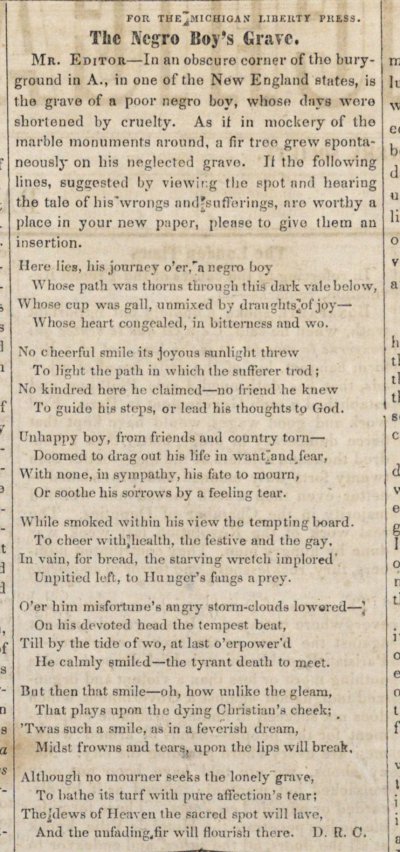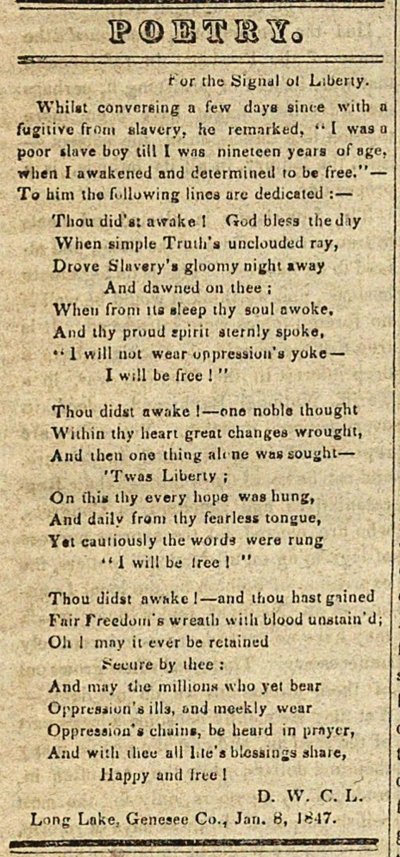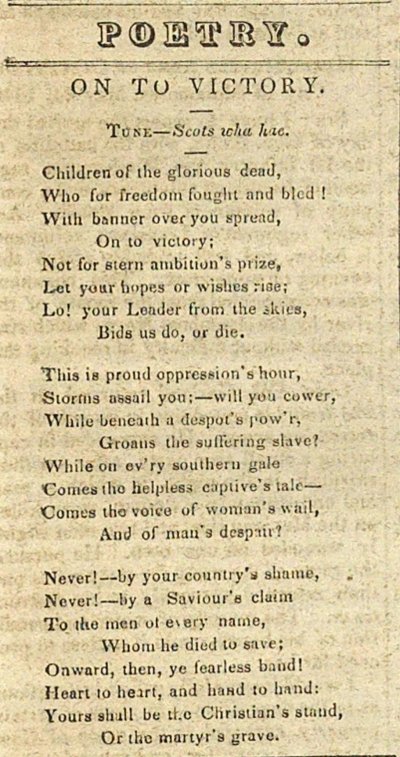
Song of the Editor: Poems and Other Miscellany in the Signal of Liberty
What’s in a Name?
On April 28, 1841, Ann Arbor welcomed its first anti-slavery newspaper, the Signal of Liberty. The Signal’s first issue recapped the sixth annual meeting of the Michigan State Anti-Slavery Society and welcomed new subscribers and advertisers. The paper’s predecessors, the Jackson-based American Freeman (1839) and Michigan Freeman (1839-1841), had folded due to financial difficulties. Theodore Foster and Rev. Guy Beckley took on the challenge of printing the society’s newspaper.

They chose a new name, Signal of Liberty, to remind readers of the cause of freedom that united them. Antislavery societies were forming across the United States and its territories in the 1830s and ‘40s, encouraging others to join in their mission to end slavery. Many newspapers took up the abolitionist cause, and some (including the Signal) promoted the affiliated Liberty Party. The Signal of Liberty (1841-1848) became Michigan’s flagship anti-slavery newspaper.
An anonymous poem printed in January 1842 likened the Signal of Liberty to a lighthouse beacon that would save “countless souls” from “tempestuous winds and raging waves.” The lighthouse acted as a metaphor for the newspaper’s mission to free enslaved people from the “greedy grasp” of slaveholders: “Built on the eternal rocks… With light as radiant as the polar star… So shines our ‘Signal.’” Another “signal” with potent symbolism referenced in the poem is the “polar star,” also known as the North Star. The North Star helped former slaves navigate their escape to freedom in the northern U.S. and Canada.


Ann Arbor’s First Presbyterian Church was the site of the founding of the Michigan State Anti-Slavery Society in 1836. When the Society’s executive committee took over publication of the newspaper several years later, Ann Arbor was a logical choice for a home base. Theodore Foster had editorial experience and Rev. Beckley was a Methodist preacher from a successful Ann Arbor business family. At the Signal of Liberty’s peak, they drew over 1,200 subscribers from Michigan, including 300 from Washtenaw County.
Foster and Beckley set up their printing equipment on the second floor of Beckley’s brother’s mercantile shop on the Huron block of Broadway in Ann Arbor. They established strong relationships with local residents and businessmen, including Caleb Ormsby of the Ann Arbor Paper Mill and William R. Perry, owner of a bookstore in Lower Town. To learn more about how they printed the newspaper on an iron handpress, check out AADL’s 2019 blog series “Paper, Ink, and Pi: Printing the Signal of Liberty.” To learn more about how they decided what to print in their paper on any given week, read on!
The Editor’s Dilemma
On May 27, 1844, the Signal of Liberty reprinted a fictional account of one man’s visit to a country newspaper office. The visitor encounters an editor “surrounded by a heap of crabbed manuscript” from correspondents and aspiring contributors. He is struggling to decide what to print in his weekly paper:

Indeed, he has but four pages in his paper; a part of those four pages must be taken up with advertisements and notices; indeed, he must have a modicum of editorial for his readers; indeed, they must needs read of what is going on in Congress, off there in Europe and in Asia, and down here in the legislature...indeed, the poet hath quite a corner, all his own; indeed, I must extract good pieces from other papers...and, indeed, I have a host of other kind correspondents besides thyself.
From breaking news to advertisements, poetry, and gossip columns, newspaper editors chose content that best represented the interests of the paper and its readers. Signal of Liberty editors Theodore Foster and Guy Beckley probably hoped this story would educate their subscribers on the labor involved in editing a paper, remind them to pay their dues, and make them laugh, too. Even an antislavery paper needed lighter material to balance out the standard political fare. The story’s narrator signs off with a hasty retreat from the printer’s office, which is overflowing with badly written correspondence from ungrateful subscribers: “Printer,” he says, “I bid thee, and thy sorrows, farewell.”
The story about the printer’s woes is borrowed from the Ohio Observer, a Presbyterian weekly, but could just as well have described the Signal of Liberty’s editorial process. An interesting aspect of 19th-century newspaper printing is the large amount of content that editors borrowed from other newspapers. They called these sources “exchange papers” or “exchanges.”
Clip! Clip! Clip!
The Signal of Liberty traded material with many other like-minded newspapers, especially abolitionist and Liberty party papers. The Signal’s first issue instructed fellow editors to send their exchanges to Ann Arbor rather than the Michigan Freeman’s prior location, Jackson. It was important to receive them in order to get the current national news and more content for the Signal’s next issues. Poems, short fiction, humorous anecdotes, and other “evergreen” or non-trending content could be reprinted weeks or even months later.
One such poem traveled to Ann Arbor following a circuitous route from St. Louis, Missouri. The “Song of the Editor” ran in the Signal of Liberty on April 14, 1845. First published in January 1845 by a Missouri-based weekly paper called the St. Louis Reveille, it traveled via regular exchange routes to Virginia and then up the eastern seaboard to Boston’s The Liberator. Edited by abolitionist William Lloyd Garrison, The Liberator was one of the Signal of Liberty’s regular exchange papers. Six weeks after the Boston paper published the poem, the Signal reprinted it.
The poem follows the morning tasks of an editor who is hastily “clipping” and “pasting” content from exchange papers:
 Clip! Clip! Clip!—
Clip! Clip! Clip!—
No ‘cabbaging’ shears his hands doth hold,
But those with which the current gold
By lawful right he’ll clip,—
The ‘Devil’ is gone, but he will not fail
Of a prompt return with the ‘morning mail’—
A basket full of ‘exchanges’—
And then the editor opens and skims—
Accidents—deaths—discoveries—whims—
As over the world he ranges!
When the editor’s assistant, also known as a “Devil,” brings him a basket of exchanges, the editor eagerly skims their pages for material to reprint in this week’s issue. He pastes them into “copy” for his compositors, who are ready to begin setting type:
 Paste! Paste! Paste!
Paste! Paste! Paste!
With camel’s hair brush and a broken cup,
He gathers the scatter’d paragraphs up,
And sticks them on in haste:
The ‘Devil’ appears with a grin and a bow—
‘Please, sir, they’re waitin’ for ‘copy’ now...’
The “Song of the Editor” was a parody of Thomas Hood’s 1843 labor protest poem “The Song of the Shirt.” Hood’s poem called attention to the poor working conditions of female laborers in the garment industry: “Stitch! Stitch! Stitch! / In poverty, hunger, and dirt…” The parody picked up Hood’s catchy repetitions and applied them to the editor’s business: “Clip! Clip! Clip!... Paste! Paste! Paste!”
As literary historian Ellen Gruber Garvey explains, reprinting was not stealing, but a lawful practice that helped spread news across the country. The United States Postal Service even waived the postage on newspapers exchanged between editors. For abolitionist or Liberty Party papers such as the Signal of Liberty, reprinting helped present readers across the nation with a unified message. The low-cost practice was a core aspect of a 19th-century editor’s job.
The Poet’s Corner
Poetry was a popular medium for 19th-century writers. Poems clipped from newspapers were shared in letters and scrapbooks and read aloud by families, schoolchildren, and members of social and political clubs. As the frazzled newspaper editor in the story above noted, “the poet hath quite a corner, all his own.” But how did the Signal of Liberty’s editors choose which poems to print?
The majority of the Signal’s non-advertising content was political in nature, and its poetry column was no exception. Usually printed on the first or fourth page, the poem of the week provided another way for readers to relate to the antislavery cause.
Typically, Foster and Beckley chose popular poems that appeared in their exchange papers, like “Song of the Editor.” Many of these were abolitionist poems describing the plight of the slave, the cruelty of slaveholders, and the ideals of freedom and liberty. Well-known authors included Henry Wadsworth Longfellow, John Greenleaf Whittier, and John Pierpont. But the Signal also featured verses contributed by local authors.
A poem published on February 24, 1845 in the correspondents’ section pressures the editors for more original poems by local writers rather than reprintings by more famous poets:
 'Tis true, that you may cull with care,
'Tis true, that you may cull with care,
And gather much that's good and rare;
But, if from other sheets you borrow,
What’s theirs to-day, is yours to-morrow;
So you, behind must slowly tread,
While they are flying on ahead.
As this poet notes, borrowed verses will always be old news. Why not publish original content from the Signal’s own subscribers? In fact, dozens of poems that were published in the Signal were by local authors–including this one:
 So modest are we, in most cases
So modest are we, in most cases
Your readers know us, but by guesses–
The initials of our name we give,
The town, or village where we live;
These signs you know, but few can tell,
And none, but those, who know us well.
The author signs off with only a town name and date: “Salem, Feb. 10th, 1845.” Close attention to similar signatures throughout the Signal’s print run give clues to the identity of this poet. Those who “knew her well” might have identified the verses of Elizabeth Ross Spence of Salem Township, just eight miles north of Ann Arbor.
Several poems appearing in the poetry column follow the same pattern: before the title appears an authentication of originality–“For the Signal of Liberty”–and the signature reads “Salem, [Date].” An elegy written for a deceased infant on September 19, 1842, “Rest, Sweet Babe, in Softest Slumber” provides the telling clue. As the note above the poem explains, “The following lines were composed by Mrs. Spence, and sung at the burial of a child of Enoch and Emma Hamilton, at Salem, Aug 1842.”

“Mrs. Spence” is Elizabeth Ross Spence, the wife of Adam Spence. She was born in Scotland around 1797 and she moved from Rhynie, Aberdeenshire, Scotland to Salem, Michigan in 1831 with her husband and young son. They established a farmstead and were founding members of the Congregational Church of Salem in 1839. Elizabeth Ross Spence, a poet and singer, was likely one of the women of the Salem Choir who “organized a Ladies Antislavery and Benevolent Association for the town of Salem” during an antislavery meeting held in a barn in Salem on May 19, 1846.
The elegies she wrote for members of her church demonstrate the care that she showed for her friends and neighbors as well as the antislavery cause. Her son Adam Spence, perhaps inspired by his parents’ abolitionist ideals, became a principal at Fisk University. The 1870 Census lists Elizabeth Ross Spence as living in Ann Arbor, age 73. Although the full extent of Elizabeth Ross Spence’s writing has not been documented, the Fisk University Archives has much of her correspondence and two books of her poems: Hymns and Songs, 1858-1878 and Poems 1876-1880. More investigation is needed, but perhaps some of her contributions to the Signal of Liberty appear in these pages.
Spence’s tongue-in-cheek rebuke to Foster and Beckley for borrowing “from other sheets” suggest that the Signal overlooked her talent, but in fact they published at least seven of her poems between 1841 and 1845.
- “The Oppressed,” Aug. 25, 1841
- “Hope for the Slave,” June 6, 1842
- “Rest, Sweet Babe, in Softest Slumber,” Sept. 19, 1842
- “Our Country,” October 17, 1842
- “Lines,” Feb. 20, 1843
- “Reply To ‘Chapter For Correspondents,’” February 24, 1845
- “Liberty Song,” April 21, 1845
Whether or not the editors themselves knew her true identity remains unclear. Nevertheless, of the hundreds of poems they chose to “clip” and “paste” into the pages of the Signal of Liberty, Spence’s verses emerge as a striking example of local talent.
________________________________________________________________________________________________________________
Anti-slavery Sonnets

- Read more about Anti-slavery Sonnets
- Log in or register to post comments
The Negro Boy's Grave

- Read more about The Negro Boy's Grave
- Log in or register to post comments
Poetry: For The Signal Of Liberty

- Read more about Poetry: For The Signal Of Liberty
- Log in or register to post comments
Poetry: On To Victory: Tune--scots Wha Hae

- Read more about Poetry: On To Victory: Tune--scots Wha Hae
- Log in or register to post comments
Poetry: Abolition Call

- Read more about Poetry: Abolition Call
- Log in or register to post comments
Poetry: The Slave Whip

- Read more about Poetry: The Slave Whip
- Log in or register to post comments
Poetry: The Warfare Of Freedom And Slavery

- Read more about Poetry: The Warfare Of Freedom And Slavery
- Log in or register to post comments
Poetry: The Song Of The Shirt

- Read more about Poetry: The Song Of The Shirt
- Log in or register to post comments
Poetry: The Branded Hand

- Read more about Poetry: The Branded Hand
- Log in or register to post comments